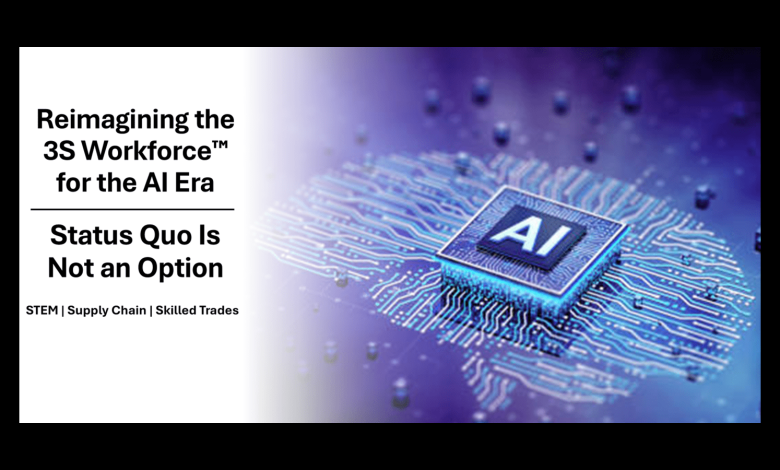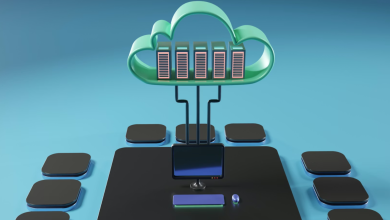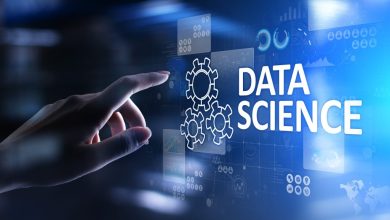
Introduction: The 3S Workforce™ and Why It’s Under Strain
As artificial intelligence (AI) moves from novelty to ubiquity, the nature of work is being reshaped in ways that go far beyond back-office automation or white-collar disruption. We stand at a pivotal moment. The convergence of rapid AI advancement, global supply-chain shocks, and an escalating shortage of skilled-trade talent has exposed a new reality.
The economy that once rested on “go to college to get a good job” is shifting toward what many call the essential economy, which contains the 3S Workforce™ -anchored in STEM (Science, Technology, Engineering, and Math), Supply Chain, and the Skilled Trades. The status quo will not suffice. We must rethink and reimagine how we prepare, connect, and mobilize youth (ages 13-24) if we are to sustain competitiveness, innovation, and opportunity in the AI era.
Why the Urgency Is Real: STEM as the Baseline
Across all three pillars, the foundational element is STEM education. It is no longer optional; it is the baseline.
Recent data underscore the scale of the challenge, as STEM jobs are projected to grow 8.1 percent between 2024 and 2034, significantly outpacing the 2.7 percent growth rate for non-STEM occupations. According to an estimate by the Semiconductor Industry Association, there will be a STEM shortage of approximately 1.4 million technicians, computer scientists and engineers in the U.S. by 2030. High-school math performance underscores the concern. Only about 20 percent of U.S. graduates are STEM-ready, and the United States ranks 34th in math among global peers according to the most recent global assessment data.
Without greater investment in STEM literacy, the pipeline into both high-tech and hands-on trades will continue to erode. Consequently, building stronger connections among STEM, supply chain, and skilled-trade pathways is critical to driving national competitiveness and innovation.
Three Urgent Fault Lines in the 3S Workforce™ Economy
1. STEM → Supply Chain → Skilled Trades: A Connected Pipeline
The three pillars are deeply interwoven. STEM underpins innovation, analytics, and digital fluency. Supply-chain careers demand that same fluency, plus systems thinking and logistical precision. Skilled trades now sit at the automation interface, where robotics, sensors, data flows, and human craftsmanship converge. Disruptions in anywhere ripple through the system.
2. Youth Expectations and Workforce Readiness
Generation Z and younger workers enter the labor market with distinct priorities: purpose, adaptability, and digital fluency. Simultaneously, many entry-level rungs are disappearing or transforming under AI. The 3S Workforce™ must meet youth where they are, offering tech-enabled, purposeful, and stable career pathways that align with their values and realities.
3. Business Risk and National Competitiveness
The widening talent gap across STEM, supply chain, and skilled trades is not merely an HR issue; it is a competitiveness issue. When the workforce cannot keep pace with technology, the result is slower innovation, rising costs, and diminished resilience in critical sectors.
Why the Numbers Demand Action
The data tell an urgent story. According to the McKinsey Global Institute, the United States and Europe will require 12 million occupational transitions by 2030 to keep pace with AI, automation, and infrastructure demand. These shifts are catalyzed and accelerated by AI adoption across every industry.
At the same time, the Manufacturing Institute and Deloitte estimate that U.S. manufacturing will need 3.8 million new workers by 2033, and recent analysis indicates that 2.1 million manufacturing and skilled-trade jobs could remain unfilled by 2030 due to skill gaps.
Youth, industry, and education systems now stand at a convergence point. As entry-level, internship, and apprenticeship opportunities evolve under AI, reimagining how we prepare young people for 3S Workforce™ careers has never been more urgent.
The Gen Z Dynamic: Purpose, Adaptability, and Digital Fluency
Young people entering the workforce today bring different expectations and face different realities. The World Economic Forum reports that up to 40 percent of employers expect to reduce workforce size as AI takes on more tasks. At the same time, younger workers prioritize purpose, stability, and meaning.
As these forces collide, the takeaway is clear: As these forces collide, the takeaway is clear: the traditional “community college or trade school” pathway must be elevated and modernized. Skilled trades, long viewed as stable careers, are now being redefined by technology, where digital literacy, human-machine collaboration, and problem-solving matter as much as the wrench, the MRI machine, or the torch.
Framework for Transformation: Four-Part Model
1. Baseline STEM Literacy to Purposeful STEM Skills
Equip students with foundational STEM (math, science, technology) and connect those skills to real-world contexts in supply-chain and trade systems. STEM is the entry point to innovation, no matter the industry.
2. Supply Chain Systems Thinking to Operational Fluency
Embed understanding of flows, logistics, data, and digital monitoring. Youth learn how goods move, where bottlenecks form, and how innovation can disrupt and improve the chain.
3. Skilled Trades Reinvented for the AI Era
Trades are no longer isolated from technology. These industries and technologies include advanced manufacturing, aerospace, artificial intelligence, automotive, clean energy, cybersecurity, medical technology, next-generation communications, and the Internet of Things, among others. The trades of tomorrow require human-machine collaboration, judgment, troubleshooting, and continuous skill refresh. The next generation of tradespeople must operate as both problem solvers and system thinkers.
4. Mindset plus Adaptability for Career Resilience
In a world where up to 40 percent of workers may need occupational transitions by 2030, adaptability is non-negotiable. Youth must develop a growth mindset, digital agility, and lifelong learning habits.
Measuring ROI: Why This Matters for Business, Youth, and Society
Business Impact
Closing the talent gap reduces vacancies, stabilizes productivity, and controls costs. With up to 1.9 million unfilled jobs by 2033, the cost of inaction is steep.
Societal Impact
A well-prepared 3S Workforce™ drives economic resilience, regional vitality, and inclusive talent utilization. Re-envisioning skilled trades through an AI-era lens strengthens industry while uplifting communities.
Youth Impact: A Generation at the Crossroads
A concerning piece of data is that for every five (5) Boomers retiring from the skilled trades, only two (2) Gen Z and Millennials are coming into the trades. This imbalance underscores a generational gap in both exposure and encouragement.
Another data point reinforces this trend: surveys of Gen Z consistently show that young people want more opportunities for experiential learning and career discovery that connect purpose with practical skills. Yet many lack clear access points—mentorship, real-world projects, and visibility into emerging industries—that would allow them to see themselves in these careers.
Disconnected youth, often caught in cycles of underemployment or disengagement, remain an untapped asset. No young person should be left behind. By rethinking how society inspires and connects youth to the essential economy of STEM, supply chain, and skilled trades, we can transform potential into progress and ensure the next generation inherits not just jobs, but purpose.
Key Takeaways for Leaders
- Do Not Wait: The talent gap is widening. Engage youth early (ages 13–17) and sustain continuous pathways.
- Make STEM Foundational: Without STEM, supply-chain and trade readiness will lag.
- Connect the Dots: Break silos between education, employers, and policymakers.
- Modernize the Narrative: Present STEM, supply-chain, and trade roles as tech-enabled, purpose-driven careers.
- Embed Adaptability: Build systems that anticipate change and enable lifelong reskilling.
Conclusion: The Era of Status Quo Is Over
The days when “any stable job will do” are gone. In the AI era and beyond, the essential economy of STEM, Supply Chain, and Skilled Trades demands earlier action, cross-sector collaboration, and bolder imagination.
The 3S Workforce™ is not a sideline, it is the front line. For youth, for business, and for society: status quo is not an option.
References
- Center for Strategic and International Studies, Innovation Lightbulb: Foreign-born Share of the U.S. STEM Workforce (April 2024), available at https://www.csis.org/analysis/innovation-lightbulb-foreign-born-share-us-stem-workforce.
- CodeWizardsHQ, “The Ultimate List of STEM Statistics 2025” (June 2025), available at https://www.codewizardshq.com/stem-statistics/.
- Deloitte, Gen Z & Millennial Survey (May 2025), available at https://www.deloitte.com/global/en/issues/work/genz-millennial-survey.html.
- Deloitte Insights: Taking Charge Manufacturers Support Growth with Active Workforce Strategies (April 2024), available at https://www.deloitte.com/us/en/insights/industry/manufacturing-industrial-products/supporting-us-manufacturing-growth-amid-workforce-challenges.html.
- iD Tech, “STEM Education Stats 2025” (Feb 2025), available at https://www.idtech.com/blog/stem-education-statistics.
- Manufacturing Dive, Labor Shortage 2033 Report (April 2024), available at https://www.manufacturingdive.com/news/manufacturing-labor-shortage-2033-deloitte-mi-report-2024/713133/.
- The Manufacturing Institute, Manufacturing Talent Study (April 2024), available at https://themanufacturinginstitute.org/study-manufacturing-in-u-s-could-need-up-to-3-8-million-workers-19758/.
- McKinsey & Company, Generative AI and the Future of Work in America (July 2023), available at https://www.mckinsey.com/mgi/our-research/generative-ai-and-the-future-of-work-in-america.
- Skillwork, The Labor Shortage In The United States: Why Are American Workers Becoming Harder to Find? (2023), available at https://skillwork.com/skilled-trades-shortage-stats/.
- United States Bureau of Labor and Statistics, Employment in STEM occupations (Last Modified Date: August 28, 2025), available at https://www.bls.gov/emp/tables/stem-employment.htm.
- World Economic Forum, AI Jobs and Automation Report – How AI is reshaping the career ladder, and other trends in jobs and skills on Labour Day (April 2025), available at https://www.weforum.org/stories/2025/04/ai-jobs-international-workers-day/.
- World Economic Forum, Future of Jobs Report 2025 (Geneva: World Economic Forum, 2025), available at https://www.weforum.org/publications/the-future-of-jobs-report-2025/.




